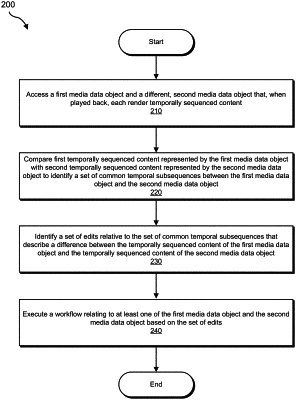| CPC H04N 21/2343 (2013.01) [G06Q 10/06312 (2013.01); G11B 27/031 (2013.01); G11B 27/10 (2013.01); H04N 21/23412 (2013.01); H04N 21/23418 (2013.01)] | 20 Claims |

|
1. A computer-implemented method comprising:
accessing a first media data object and a different, second media data object that, when played back, each render temporally sequenced content;
comparing first temporally sequenced content represented by the first media data object with second temporally sequenced content represented by the second media data object to identify a set of common temporal subsequences between the first media data object and the second media data object;
identifying a set of edits relative to the set of common temporal subsequences that describe a difference between the temporally sequenced content of the first media data object and the temporally sequenced content of the second media data object; and
executing a workflow relating to at least one of the first media data object and the second media data object based on the set of edits.
|